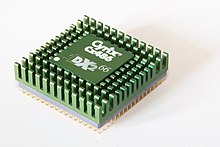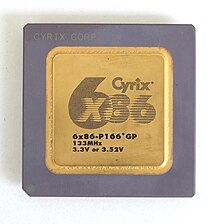Cyrix
| Cyrix Corporation
|
|
|---|---|
| legal form | Corporation |
| founding | 1988 |
| resolution | November 11, 1997 |
| Seat |
Richardson (Texas) , USA |
| Number of employees | about 300 |
| Branch | microelectronics |
| Website | http://www.cyrix.com/ ( Memento from May 29, 1998 in the Internet Archive ) |
Cyrix was an American company headquartered in Richardson, Texas that developed microprocessors for personal computers. Cyrix was founded in 1988 by former employees of Texas Instruments .
Cyrix was a so-called fabless company , so it did not have its own production facilities. Instead, it was commissioned by Texas Instruments , SGS-Thomson or ST Microelectronics and IBM , then later by National Semiconductor and finally by TSMC . This circumstance had the consequence that Cyrix processors were often also sold by the manufacturing partners under their names. The IBM versions of these processors in particular became very popular.
The company's first products were math coprocessors for 8086 processors. In 1992, with the Cx486SLC, the first full-fledged x86 microprocessor was brought onto the market. Since Cyrix could not fall back on a patent exchange agreement with Intel, in contrast to AMD all processors were completely developed in-house and were only compatible with the Intel processors. Due to its own architecture, there were often problems with mainboards and application software, which earned Cyrix a rather bad reputation.
history
The aforementioned Cx486SLC appeared in June 1992 and, together with the Cx486DLC, was intended for 80386 mainboards, but had features of the 80486 generation. With these processors, relatively inexpensive PC systems were possible because older components could be used. Nevertheless, the sales figures were rather modest , mainly due to the lower performance compared to Intel's i486 family.
In May 1993, Cyrix then launched the Cx486S, their first processor for 80486 mainboards. This corresponded to the i486SX and therefore did not have a math co-processor. This came as a surprise, because up until then Cyrix had mainly built math co-processors, which were selling well with full compatibility, mainly due to their very high performance - the Cyrix 387DX was up to ten times faster than the Intel 387. In the course of 1993, the range of 80486 processors was completed with the Cx486DX and the Cx486DX2 , which largely corresponded to their respective Intel counterparts ( i486DX and i486DX2 ). However, the Cyrix processors were used with other (higher) clock rates and were sold much cheaper.
The hybrid processors Cx486SLC and DLC also had successors in September in the form of the Cx486SRx² and the Cx486DRx² . Both processors largely corresponded to their predecessors, but like the Cyrix Cx486DX2 had an internal clock doubling, which made significantly higher clock rates possible.
In 1995, with the Cyrix Cx486DX4 , another refresh of the Cx486 family came on the market, and with the Cyrix 5x86, a very interesting CPU. The Cyrix 5x86 (code name M1sc) was again a hybrid CPU, but this time for 80486 mainboards, but was already based on the advanced design of the 6x86 . The CPU was thus a perfect upgrade CPU for 486 motherboards, and many upgrade kits from third-party companies such as Evergreen appeared with it .
The aforementioned Cyrix 6x86 (code name M1), on the other hand, was developed for Socket 5 and is therefore pin-compatible with the Intel Pentium . It should be noted that the integer performance of the 6x86 was so far superior to the Intel Pentium that a CPU with only 133 MHz was faster than a Pentium 166. That is why the so-called P-Rating (PR) was introduced so that the CPUs could be compared.
In response to the Intel Pentium MMX , the Intel Pentium II and the AMD K6 (all with MMX technology), Cyrix introduced the Cyrix 6x86MX (M2) on May 30, 1997 . This CPU was largely based on the old Cyrix 6x86, but was equipped with a larger L1 cache , improved branch prediction and an MMX-compatible technology ( EMMI ).
All in all, it was a pretty good CPU, which, thanks to the improvements in the integer area, was able to boast and in turn achieved a higher performance than the competing products with the same clock frequency . For this reason, a P rating was used again. Another change compared to the 6x86 was the use of significantly more flexible multipliers: x2.5 became possible and thus a much larger range of clock frequencies.
Until then, technically things looked pretty good for Cyrix: They had a competitive CPU, a relatively high market share and many patents. Financially, things were not going as well: They had been making losses for years, the battle with Intel and AMD cost a lot of money, and ultimately the AMD K6 was also able to win many fans, which depressed the sales figures for the 6x86MX.
In November 1997, the takeover by National Semiconductor was announced. With NatSemi behind them, it was assumed that Cyrix could continue to offer competitive products in the future, with the Cayenne / Gobi design a corresponding CPU was being developed.
The first disappointment followed on April 15, 1998: Cyrix presented the Cyrix MII on that day . However, this CPU was not new, it was just a renamed 6x86MX. The first MII were the MII-300 and the MII-333. These CPUs were certainly not bad, but the architecture was already a year old and against the AMD K6-2 and the Intel Pentium II you could - v. a. also because of the low clock rates - do not exist. Incidentally, IBM did not go along with the fad of the name change and continued to sell the MII-300 and -333 as the 6x86MX-PR300 and 6x86MX-PR333.
Cyrix fell behind, and sales plummeted. Now it also turned out that NatSemi was more interested in System-on-a-Chips (SoC) in the form of MediaGX processors than in desktop CPUs. That was disastrous for the development of a new desktop CPU. In mid-1999, the news came that NatSemi was selling Cyrix to VIA Technologies ( Taiwan ). As a first measure VIA announced the production of the MII CPUs at TSMC , and thanks to the -Shrinks to 0.18 microns, the clock rates increased slightly, and they brought still the MII-366, MII-400 and MII-433 on the Market.
At the beginning of 2000 a new CPU named Cyrix, the VIA Cyrix III , was finally presented to the public. This CPU had been in development for so long that it was given three different code names: Development originally began under the name “Cayenne” when Cyrix was still independent. After the merger with NatSemi, the code name was changed to "Gobi". But the CPU could not be completed in the two years that it was part of NatSemi. Only after the takeover by VIA Technologies was the CPU ready under the code name "Joshua".
Due to the long development time, one could actually expect a mature product, but the VIA Cyrix III was only a very interesting CPU for the Socket 370 on paper and disappointed in the first preliminary tests: instabilities, high heat generation and very low clock rates combined with completely utopian P- Ratings (because they were set too high) led VIA Technologies to abandon the Joshua design completely and instead sell the Samuel developed by Centaur Technology as the VIA Cyrix III.
estate
The CPU technology from Cyrix was later only used in the Geode CPUs from National Semiconductor. The Geode SoCs were based on the design of the Cyrix MediaGX and were slightly improved by National Semiconductor. The SoC division was taken over by AMD in 2003 . AMD offered the same product under the name Geode GX . In 2005 a further improved version of the old Cyrix MediaGX was released with the Geode LX. The Geode NX also offered by AMD was based entirely on the architecture of the AMD Athlon XP .
On October 24, 2005, AMD licensed Cyrix x86 technology to the Chinese Ministry of Science and Technology (MOST) and Beijing University for the development of embedded and low-power x86 components.
Today, Cyrix technology is no longer actively branded by its current owners.
Mathematical coprocessors
Cyrix 287
- Cyrix 287XL (+)
- Cyrix CX-82S87
Cyrix 387
- Cyrix CX-EMC87 or AutoMATH
- Cyrix Cx87DLC
- Cyrix 387DX
- Cyrix 387SX
- Cyrix 387SL
FasMath
- CyrixCX-83D87
- CyrixCX-83S87
- Cyrix 387DX +
Processors
80486 ( Cyrix Cx486 family )
5th generation
6th generation
See also
Individual evidence
- ↑ Cyrix processors from 287 The CPUShack Museum





